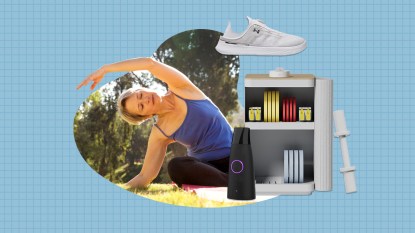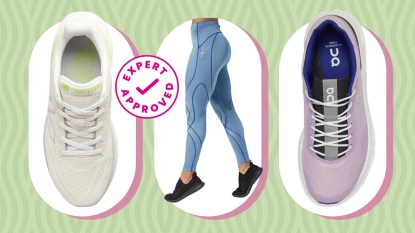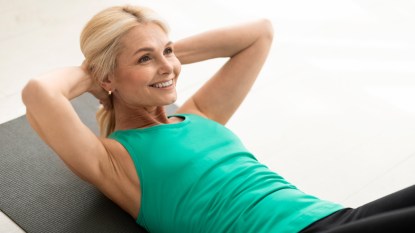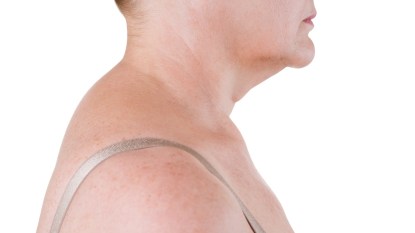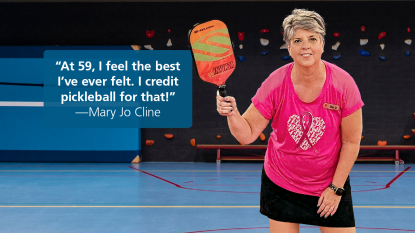Do These Water Aerobics Exercises To Improve Heart and Cardiovascular Health
This aquatic activity boosts your health and is fun to do.
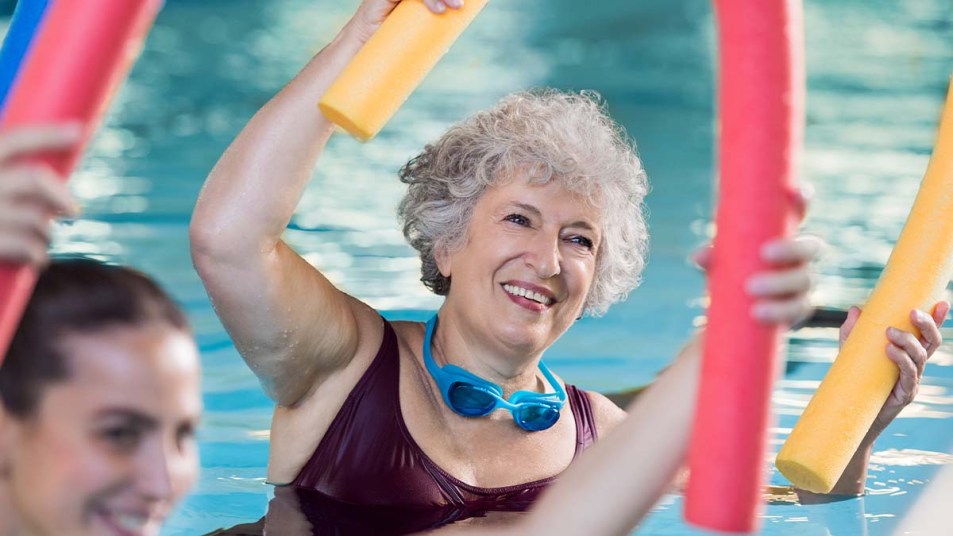
On a mission to boost your heart health? Water workouts might be just the thing. While you might think you need to get on the treadmill — or some similar torture device — to improve your cardiovascular health, it’s not actually necessary. Aquatic exercises work just as well.
In a 2020 cross-sectional study, researchers found that water aerobics are an effective way to protect against heart disease. So if you’re looking for an alternative to the grueling sweat and grunt exercises you know and don’t love, water aerobics might be just the thing. Read on to discover the best water aerobics exercises to improve your heart and cardiovascular health.
But first, what exactly is water aerobics, anyway?
When you think of pool exercises in the water, your mind likely wanders to synchronized swimming. Considering the finesse required for this, it would be natural to think water aerobics isn’t for you. But the truth is that water aerobics is a low-impact, full-body cardio workout for everyone, regardless of age or fitness level. Beginners can benefit just as much from working against the resistance of the water as those who are more experienced.
Simply put, water aerobics (also called aqua aerobics and aqua-fit) is a full-body workout that provides cardiovascular conditioning, increasing your breathing, and pulse rate. The term “aerobic” literally translates to “with oxygen,” meaning that your breathing controls the amount of oxygen that reaches your muscles to help them move and burn stored fuel. Meanwhile, you burn calories while getting into better shape.
Water aerobics classes are similar to a normal fitness class, but since they’re done in the water, they’re easier on the joints. Here are some other great benefits of water exercise:
They’re low-impact.
One of the best things about water aerobics is in their name; they happen in the water. Because of this, they significantly reduce strenuous impact on the body, making them a great option for people with joint pain due to arthritis or osteoporosis.
They enhance flexibility.
Water aerobics requires a lot of twisting, stretching, and other movements in various directions while adjusting to the push and pull of H2O; hence the joints increase their range of motion. Through all those lunges and jumping jacks in the water, you’ll find that your body becomes more flexible. A 2013 study found water aerobics participants experienced a significant increase in mobility and flexibility after just a few short months.
Aqua exercises build endurance.
Unlike dumbbells, which require the body to pull and push against weight plus gravity, water offers a natural resistance that requires the body to work through it, which helps to build endurance.
It burns calories.
Water aerobics is a blend of cardio and strength training exercises amplified by water resistance. This gentle, natural resistance ensures that the body gets a full workout. Keeping in mind factors like weight, cardio activity, and buoyancy, you can burn up to 500 calories per hour of aquatic exercise.
Water workouts support heart health.
The American Heart Association (AHA) and the American College of Sports Medicine (ACSM) recommend combining aerobic exercise with resistance training to improve heart health and overall wellness. While there are many different types of aerobic exercise that you can rely on to support a healthy ticker, the buoyancy of the water makes aqua aerobics an excellent choice. This is because water pressure allows your blood flow to circulate more effectively throughout the body, decreasing blood pressure and ultimately putting less stress on the heart.
Keeping your heart in tip-top shape is vital to living a long and healthy life — one out of every five deaths in the United States is linked to heart disease, so cardio work is of the utmost importance. Fortunately, water aerobics offers a great way to keep your cardiovascular system in good health!
The online video class Quick Burn: Low-Impact Cardio Workout provides a low-impact cardiovascular workout that can be done in just 7 minutes.
Which water aerobics exercises are best for heart health?
Now that you’re up to speed on the benefits of water aerobics, let’s take a look at a few exercises, shall we? To improve your heart and cardiovascular health, do the aqua aerobics exercises listed below.
Aqua Jogging
This fun exercise can be as simple as jogging through the water from one side of the pool to the other. You can also modify it by walking back and forth in the shallow water of the swimming pool (called “water walking) or jogging in place. Once you’ve increased your endurance, you can make this exercise a bit more of a challenge by steadily increasing your jogging speed. You can also try running a zig-zag pattern along the pool wall to create a more intense workout and torch more calories.
The Noodle Straddle
Grab a pool noodle and straddle it with your legs in the deeper end of the swimming pool. Think of it like sitting on a motorcycle or horse. Pedal your feet in the deep water as fast as possible while simultaneously opening and closing your arms. To stay steady, sit up tall and keep your spine straight. Do this for five to 10 minutes, making sure not to lean forward. (It’s tougher than it sounds since the noodle naturally wants to float upwards.)
Tuck Jumps
Tuck jumps sound easy enough, but once you’re in the water, you’ll find that this exercise is quite the cardiovascular challenge when performed repeatedly. To do this pool workout, stand in the shallow end of the pool and jump, tucking your knees to your chest each time. For an added challenge, do your tuck jumps in the deeper end of the pool where your feet will not touch the floor.
Tombstone Kick
Want to tone your arms, abs, and glutes while giving your heart a fabulous workout? The tombstone kick is the ticket. With your back to the edge of the pool, hold a kickboard with both hands so that it’s vertical and half below the water’s surface. Push off the wall with your feet, holding the kickboard in a tombstone position. Kick as hard as you can until you reach the opposite side of the pool. Repeat five to ten times.
Treading Water
Anyone who has ever had to tread water knows it’s not easy. It’s excellent for the upper body and can help you to torch around 11 calories per minute; that’s the same as jogging six miles per hour. The key is in the resistance. As mentioned earlier, water provides a natural and continuous resistance, engaging more muscles through a broader range of motion.
To tread water, use all four limbs with your body upright. Regulate your breathing to conserve energy and move your arms back and forth in the water. Kick your legs in a circular motion or back and forth to keep your head afloat.
Flutter Kicks
Last on the list, but certainly not least, are flutter kicks. You can perform this great low-impact cardio exercise with or without a kickboard. If you use one, hold it out in front of you and flutter-kick your legs to propel your body back and forth across the pool. If you don’t have a kickboard, simply perform a front float with your head above water while holding onto the edge of the pool and flutter kick your legs. Whether you have a kickboard or not, kick your legs at a steady tempo that doesn’t tucker you out too quickly but also gets the heart pumping.
A Final Word
Whether your goal is to torch calories for weight loss, build muscular endurance, or support a healthy heart, the water aerobics exercises listed above will help. Just be sure to drink plenty of H2O to keep dehydration at bay. (While you may not think you can become dehydrated when working out in a swimming pool, it’s actually quite common.) With this in mind, enter the pool hydrated from the start. Drink a few cups of H2O before your aerobics class and take some sips throughout the workout. If you feel extremely thirsty or dizzy at any point, stop what you’re doing and rehydrate.





